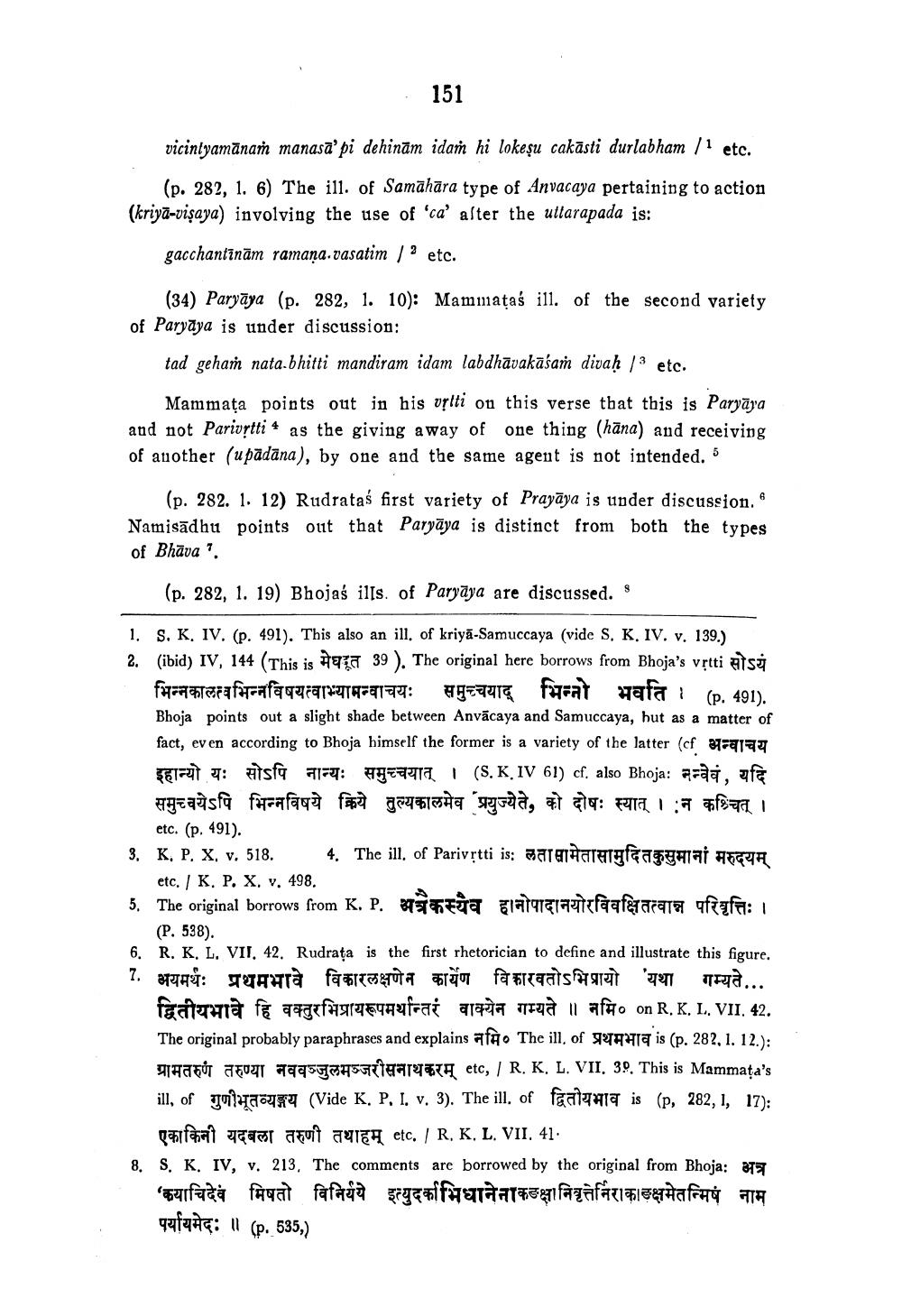________________ 151 vicinlyamanam manasa'pi dehinam idam hi lokesu cakasti durlabham /1ete. (p. 282, 1. 6) The ill. of Samahara type of Anvacaya pertaining to action (kriya-visaya) involving the use of 'ca' after the uttarapada is: gacchantinam ramana.vasatim / etc. Mammatas ill. of the second variety (34) Paryaya (p. 282, 1. 10): of Paryaya is under discussion: tad geham nata.bhitti mandiram idam labdhavakasam divah / etc. Mammata points out in his vytti on this verse that this is Paryaya and not Parivrtti 4 as the giving away of one thing (hana) and receiving of another (upadana), by one and the same agent is not intended. 5 (p. 282. 1. 12) Rudratas first variety of Prayaya is upder discussion. 6 Namisadhu points out that Paryaya is distinct from both the types of Bhava ? (p. 282, 1. 19) Bhojas il[s. of Paryaya are discussed. S 1. S. K. IV. (p. 491). This also an ill. of kriya-Samuccaya (vide S. K. IV. v. 139.) 2. (ibidy IV, 144 (Thisis मेघदूत 39 ). The original here borrows from Bhoja's vrtti सोऽयं भिन्नकालत्वभिन्न विषयत्वाभ्यामन्याचयः समुच्चयाद् भिन्नो भवति / (p. 491). Bhoja points out a slight shade between Anvacaya and Samuccaya, hut as a matter of fact, even according to Bhoja himself the former is a variety of the latter (cf 87-9199 इहान्यो यः सोऽपि नान्यः समुच्चयात् / (S.K.IV 61) cf. also Bhoja: नन्वेवं. यदि समुच्चयेऽपि भिन्न विषये क्रिये तुल्यकालमेव प्रयुज्येते, को दोषः स्यात् / न कश्चित् / etc. (p. 491). 3. K. P. X. v. 518. 4. The ill. of Parivrtti is: लतासामेतासामुदितकुसुमानां मरुदयम् etc. | K. P. X. V. 498. 5. The original borrows from K. P. ' हानोपादानयोरविवक्षितत्वान्न परिवृत्तिः / (P. 538). 6. R. K. L. VII. 42. Rudrata is the first rhetorician to define and illustrate this figure. अयमर्थः प्रथमभावे विकारलक्षणेन कार्येण विकारवतोऽभिप्रायो 'यथा गम्यते... द्वितीयभावे हि वक्तुरभिप्रायरूपमर्थान्तरं वाक्येन गम्यते // नमि० on R. K. L. VII. 42. The original probably paraphrases and explains नमि. The ill. of प्रथमभाव is (p. 282. 1. 12.): ग्रामतरुण तरुण्या नववजुलमञ्जरीसनाथकरम् etc, | R. K. L. VII. 32. This is Mammata's ill, of गुणीभूतव्यङ्गय (Vide K. P. I. v. 3). The ill. of द्वितीयभाव is (p, 282, 1, 17): एकाकिनी यदबला तरुणी तथाहम् etc. | R. K. L. VII. 41. 8. s. K. IV, v. 213. The comments are borrowed by the original from Bhoja: अत्र 'कयाचिदेवं मिषतो विनिर्यये इत्युदर्काभिधानेनाकङक्षानिवृत्तेनिराकाङक्षमेतन्मिषं नाम पर्यायमेदः // (p. 535,)




